
Grevillea flexuosa, commonly known as zigzag grevillea or tangled grevillea, is a species of flowering plant in the family Proteaceae and is endemic to the south-west of Western Australia. It is an erect shrub with divided leaves, these lobes with three to five triangular lobes, and cylindrical clusters of cream-coloured to pale yellow flowers.

Leptoceras menziesii, commonly known as rabbit orchid, is a plant in the orchid family, Orchidaceae and the only member of the genus Leptoceras. It is a slender plant, usually found in large colonies and which only flowers after fire. The flowers are small, white, pink and red on a stem up to 30 cm (10 in) tall and is endemic to southern Australia. It was one of the first orchids from Western Australia to be described and was given the name Caladenia menziesii, a name still used by some authorities.
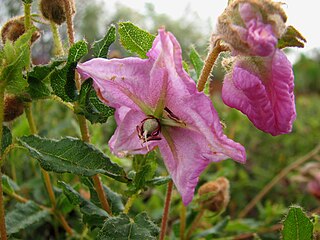
Thomasia grandiflora, commonly known as large-flowered thomasia, is endemic to the south-west of Western Australia. The flowers are pinkish-purple with a papery appearance hanging in pendents from the leaf axils. The calyx lobes are prominent and larger than the petals.
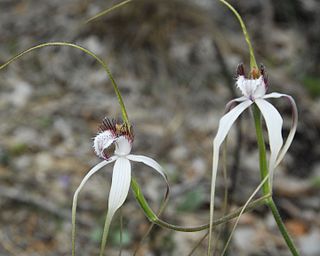
Caladenia longicauda is a species of plant in the orchid family Orchidaceae and is endemic to the south-west of Western Australia. It is distinguished by its large leaf and by its up to five large, white flowers which have drooping sepals and petals with long, thickish brown "tails".

Adenanthos barbiger, the hairy jugflower or hairy glandflower, is a species of shrub in the family Proteaceae. It is endemic to the south-west of Western Australia. It usually grows to 1 metre high, and has bright red flowers that appear mostly between August and December. The species was first formally described in 1839 by English botanist John Lindley in A sketch of the vegetation of the Swan River colony.

Eremaea pauciflora is a plant in the myrtle family, Myrtaceae and is endemic to the south-west of Western Australia. It is a shrub with small leaves and orange flowers at the ends of its branches. It has the most widespread distribution of the eremaeas with considerable variation in its characteristics so that three varieties are recognised. It was the first Eremaea to be described formally but was not originally given the name Eremaea.

Conothamnus is a genus of flowering plants in the family Myrtaceae and is endemic to the south-west of Western Australia. They are woody shrubs similar to melaleucas but differ in that their leaves are usually arranged in opposite pairs and the maximum number of seeds per fruit is three.

Verticordia densiflora, commonly known as compacted featherflower, is a flowering plant in the myrtle family, Myrtaceae and is endemic to the south-west of Western Australia. It is a shrub with small leaves, usually small pink and white flowers and which is widespread in the south-west of the state. It is a variable species and in his 1991 paper, Alex George formally described five varieties.

Darwinia pinifolia is a species of flowering plant in the family Myrtaceae and is endemic to the southwest of Western Australia. It is a low, spreading to prostrate shrub with linear leaves and dense heads of erect, red to purple flowers.

Darwinia thymoides is a species of flowering plant in the myrtle family Myrtaceae and is endemic to the south-west of Western Australia. It is a low, spreading to prostrate shrub with linear to lance-shaped leaves and groups of 4 to 8 green, red or white flowers surrounded by leaf-like bracts.
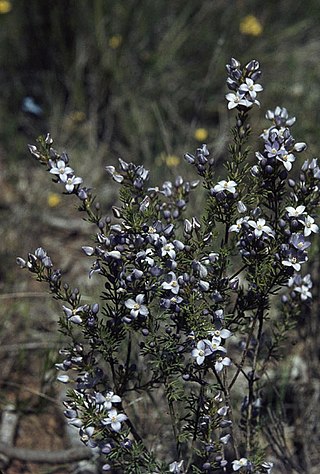
Cyanothamnus ramosus is a species of plant in the citrus family Rutaceae and is endemic to the southwest of Western Australia. It is an erect, mostly glabrous shrub with pinnate leaves with up to seven leaflets, and white, four-petalled flowers with blue or pale green backs.
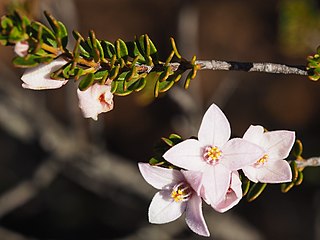
Boronia scabra, commonly known as rough boronia, is a plant in the citrus family, Rutaceae and is endemic to the south-west of Western Australia. It is an open shrub with simple, often clustered, oblong to elliptic leaves, and pink, mostly four-petalled flowers.
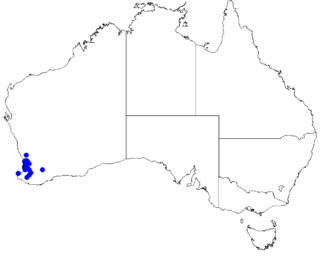
Cyanothamnus tenuis, commonly known as blue boronia, is a species of plant in the citrus family, Rutaceae, and is endemic to the southwest of Western Australia. It is a slender shrub with thread-like, sessile leaves, and flowers with four petals that are white to pink on the front and pale blue on the back.

Philotheca nodiflora is a species of flowering plant in the family Rutaceae and is endemic to Western Australia. It is a weak shrub with more or less cylindrical leaves and blue to pink flowers arranged in compact heads.

Conostephium minus, common name pink-tipped pearl flower, is a species of flowering plant in the family Ericaceae and is endemic to the southwest of Western Australia. It is an erect shrub with linear leaves and white and purplish-pink flowers.
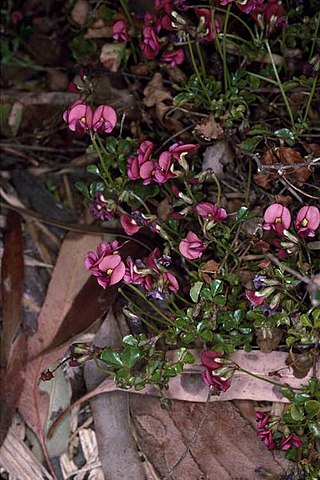
Kennedia glabrata, commonly known as Northcliffe kennedia, is a species of flowering plant in the family Fabaceae and is endemic to the south-west of Western Australia. It is a prostrate shrub or creeper with trifoliate leaves and orange-pink to red flowers with a yellow centre.

Lechenaultia juncea, commonly known as scarlet leschenaultia, is a species of flowering plant in the family Goodeniaceae and is endemic to the south-west of Western Australia. It is an open, ascending shrub with narrow, crowded, rather fleshy leaves, and scarlet to orange-red flowers.

Lasiopetalum glutinosum is a species of flowering plant in the family Malvaceae and is endemic to the south-west of Western Australia. It is a spreading, multi-stemmed shrub with densely hairy young stems, egg-shaped leaves often with three lobes and bright pink or dark red flowers.
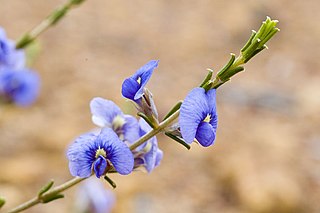
Mirbelia floribunda, commonly known as purple mirbelia, is a species of flowering plant in the family Fabaceae and is endemic to the south-west of Western Australia. It is an erect, slender or straggling, much-branched shrub with narrowly linear leaves and bluish-purple flowers.

Mirbelia ramulosa is a species of flowering plant in the family Fabaceae and is endemic to the south-west of Western Australia. It is an erect, much-branched, spiny, leafless shrub with yellow and red, purple or brown flowers.






















